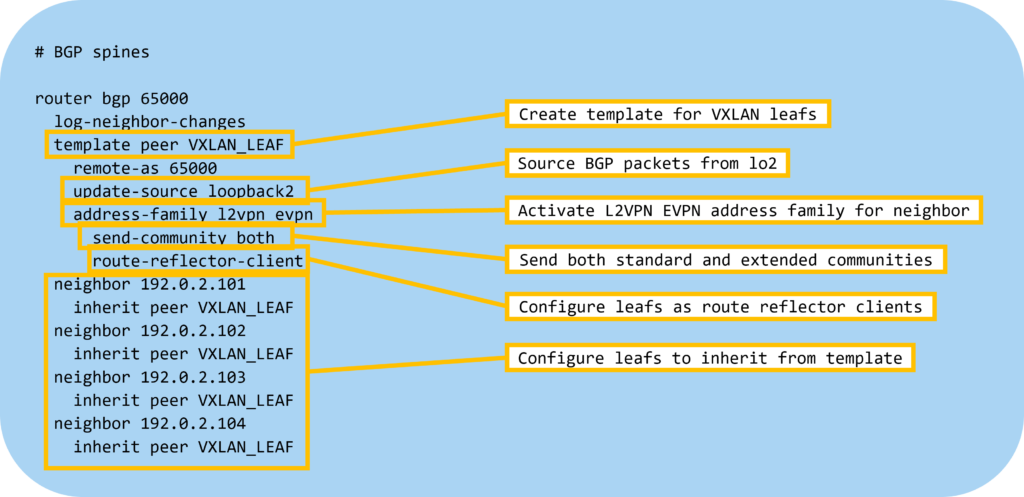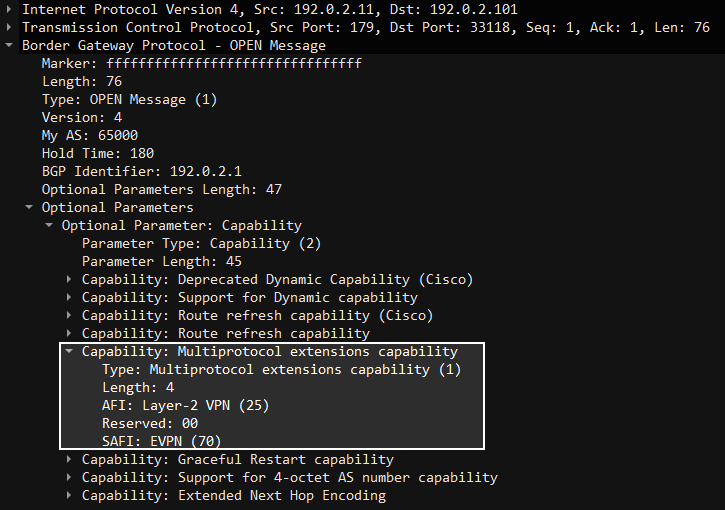In this post we will configure EVPN on NX-OS. We will reuse the VXLAN topology from my previous post. The following will describe the setup in this post:
- VXLAN topology with OSPF as the IGP in the underlay using unnumbered links.
- EVPN in the overlay using iBGP.
- Spines acting as route reflectors.
- Separate loopbacks for IGP, BGP, and NVE.
- Ingress replication based on EVPN.
- Enhancements such as anycast gateway, ARP suppression, etc., will be covered in future posts.
The BGP topology is shown below:

I will cover all the details of configuring EVPN and establishing the BGP sessions. We will then cover the actual exchange of routes in detail in separate posts in the future.
Starting out, the following globals and features need to be configured:

Next, let’s configure BGP on the spines with the following settings:

Then let’s configure BGP on the leafs:

The devices will now advertise that they have AFI L2VPN and SAFI EVPN:

The BGP sessions are now up:
Leaf1# show bgp l2vpn evpn sum BGP summary information for VRF default, address family L2VPN EVPN BGP router identifier 192.0.2.3, local AS number 65000 BGP table version is 4, L2VPN EVPN config peers 2, capable peers 2 0 network entries and 0 paths using 0 bytes of memory BGP attribute entries [0/0], BGP AS path entries [0/0] BGP community entries [0/0], BGP clusterlist entries [0/0] Neighbor V AS MsgRcvd MsgSent TblVer InQ OutQ Up/Down State/PfxRcd 192.0.2.11 4 65000 36 36 4 0 0 00:30:29 0 192.0.2.12 4 65000 36 36 4 0 0 00:30:29 0 Neighbor T AS PfxRcd Type-2 Type-3 Type-4 Type-5 192.0.2.11 I 65000 0 0 0 0 0 192.0.2.12 I 65000 0 0 0 0 0
At this point we have successfully configured EVPN. There is nothing being advertised yet as no L2 or L3 services have been configured for EVPN. We are saving that for the next post where I will start covering the different route types in EVPN.
Hi Daniel,
Could you confirm for me that the physical links between spins and leafs are unnumbered associated with loopback2 in ospf as IGP to provide BGP connection?
Thank you
Yes, that’s correct. I use three loopbacks:
Loopback0 – Router ID
Loopback1 – VTEP VXLAN
Loopback2 – BGP EVPN
Hi Daniel,
first of all, thank you very much for all your great posts 🙂
I think you forgot to add Loopback2 interface configuration in either this or your previous LAB post.
Just for your information.